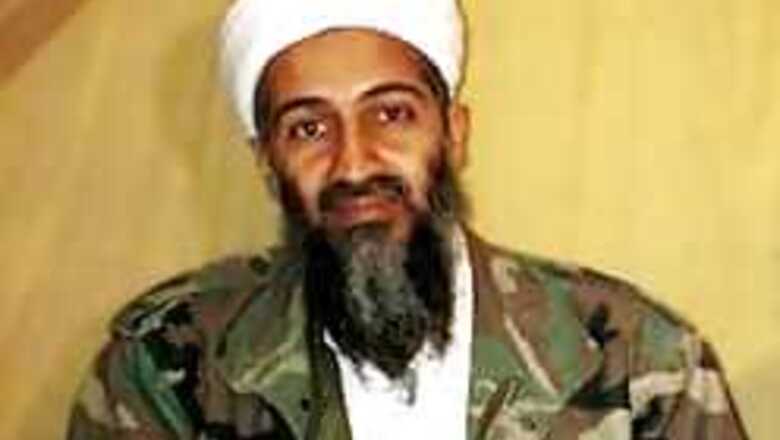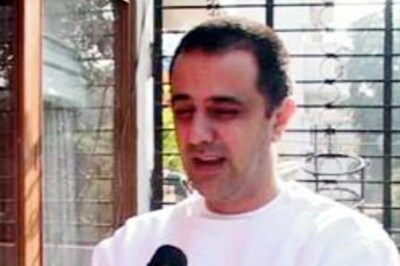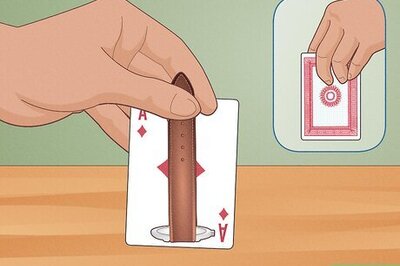
views
Afghanistan-Pakistan Border: The al-Qaeda terror camps are gone from Afghanistan, but the enigma of Osama bin Laden still hangs over these lawless borderlands where tens of thousands of US and Pakistani troops have spent nearly five years searching for him.
Villagers say the CIA missed by only a few miles when it targeted bin Laden's top deputy, Ayman al-Zawahri, with a missile strike in January. Then in May, US Special Forces arrested one of al-Zawahri's closest aides, suggesting the trail has not gone entirely cold.
He may be nearby, yet hopes of cornering the Saudi-born al-Qaeda leader seem distant as ever. The last time authorities said they were close to getting him was in 2004, and in hindsight those statements seem more hope than fact.
Five years after the September 11 attacks, the most publicized manhunt in history has drawn a blank. The CIA has reorganized agents searching for the al Qaeda leaders in the face of the evolving nature of the terrorist threat. And the American military's once-singular focus is diffused by the need for reconstruction and a growing fight against the Taliban, the resurgent Afghan Islamic movement that once hosted bin Laden.
American soldiers climbing through the forested mountains of Afghanistan's Kunar province - where in the 1980s bin Laden fought in the US-backed jihad against the Soviets - still hope to catch or kill him. But they say bolstering the Afghan government is their primary mission now, amid the worst upsurge in Taliban attacks in five years.
''It is like chasing ghosts up there,'' said Sgt George Williams, 37, of Watertown, NY, part of the Army's 10th Mountain Division pushing into untamed territory along the border with Pakistan. ''Osama bin Laden is always going to be a target of ours as long as he is out there, but there are other missions: to rebuild Afghanistan and attack the militants still here.''
The top leaders of al-Qaeda remain free despite more than 100,000 US, Afghan and Pakistani forces at the frontier. High-tech listening posts, satellite imagery, unmanned spy planes - not to mention a $25 million bounty on each man from the US government - all aid the hunt.
Yet both bin Laden and al-Zawahri are communicating to the outside world, posting messages on Islamic Web sites to inspire further attacks on the West. Although the al-Qaeda leaders are too isolated to run directly a terrorist operation like September 11, Pakistan says the latest alleged plot, to bomb US-bound jetliners from Britain, may have been blessed by al-Zawahri.
The frustrating campaign has frayed critical cooperation between Afghanistan and Pakistan, neighbors separated by an ill-defined frontier and a history of mutual suspicion.
Pakistan has captured most of bin Laden's lieutenants, including 9/11 attacks coordinator Khalid Sheikh Mohammed, and claims to have reduced the remaining al-Qaeda command to mere figureheads. Pakistan has lost 350 troops fighting al-Qaeda and Taliban-linked militants.
PAGE_BREAK
Yet Afghan officials allege that Pakistan is sanctuary for Taliban rebel leaders and lets them recruit from radical Islamic schools. They even suggest that Pakistan is hiding bin Laden, perhaps to ensure Pakistan remains of strategic importance to Washington.
''We believe he is being kept as a prize, as an ultimate bargaining chip,'' said a senior Afghan government official, who declined to be identified due to the sensitivity of his comments.
Latfullah Mashal, a former Afghan Interior Ministry spokesman, goes so far as to pinpoint bin Laden's hideout in a remote valley in Pakistan's North Waziristan region. He says there's a mountain fortress with a network of tunnels, guarded by African militants who never venture outside.
Pakistan, which formally ended its support for the Taliban after the Sept. 11 attacks, rejects both allegations. It has about 80,000 troops in its wild tribal regions along the Afghan frontier, including a US-trained and equipped quick-reaction force.
''I don't think any other country has played a bigger role than Pakistan,'' said Interior Minister Aftab Khan Sherpao.
Retired Lt. Gen. Ali Mohammed Jan Aurakzai, who led the Pakistani army into the region after the Sept. 11 attacks, said sealing the border between Afghanistan and Pakistan would require between 150,000 and 200,000 troops ''and still there's no 100 percent guarantee that infiltration would not take place.''
Strained by the demands of Iraq, the US has only about 20,000 troops in Afghanistan. The roughly 10,000 in the border area must cover about 30,000 square miles of some of the most forbidding territory on Earth: jagged mountains, both arid and forested, that become impassable in winter. There are steep valleys and rushing rivers spanned by rickety rope bridges; dark caves that could be booby trapped. Deeply religious and xenophobic villagers also obstruct efforts to run down al-Qaeda remnants.
''Bin Laden has a network of contacts and places to go to if he needs to that's pretty close to 20 years old. He's a veteran of that region, so it's very hard to find him,'' said Michael Scheuer, who once headed the CIA unit that was dedicated to hunting the al-Qaeda leader. ''Bin Laden's status as a hero in the Islamic world is also a telling factor in why he's not been caught.''
A senior former Pakistani intelligence official put it more bluntly. ''These (ethnic) Pashtuns have their own traditions. They'll die but they'll not hand over bin Laden,'' said the official, who declined to be named because of the secretive subject matter.
PAGE_BREAK
For US troops, the Afghan mission is increasingly dangerous. At least 272 US service members have died in and around Afghanistan since October 2001, including three recently from Williams' unit. Some 44 US service members died in Afghanistan in 2004, 92 in 2005 and 61 so far in 2006.
Western, Afghan and Pakistani officials agree that the nearest they got to bin Laden was in the Tora Bora mountains, south of Kunar, in November 2001 when he was fleeing the US-backed war that toppled the Taliban regime.
The Pakistani intelligence official said Pakistan at first thought bin Laden was dead, perhaps killed by a bomb at Tora Bora, until a letter he penned to his family was recovered from Khalid Sheikh Mohammed when he was arrested in March 2003.
After that, repeated attempts have been made to get bin Laden and al-Zawahri:
The missile killed at least 13 civilians. Reports that a number of senior al-Qaeda operatives also died were never confirmed, as none of their bodies were found.
The associate who allegedly hosted al-Zawahri, a timber merchant and tribal chief called Haji Nader, was later arrested by US Special Forces and taken to the American air base in Bagram, Afghanistan, said Commander Youssef, police chief in Naray, where the military also has a base.
PAGE_BREAK
Youssef declined to give further details, but Pakistani intelligence officials and local residents said the arrest was made in May in Kunar province and that Nader's family in Pakistan had since received a letter from him, sent from Bagram. The US military declined to confirm the information.
Talk of al-Zawahri's whereabouts persists. In Pakistan's Bajur region, opposite Kunar, tribesmen say al-Zawahri moves with a small entourage between Pakistan and Afghanistan. They say al-Zawahri briefly visited near Damadola in July and got engaged or married to the teenage daughter of another local associate, Kawas Khan, and the ceremony was attended by tribal elders including pro-Taliban militants.
Pakistani intelligence confirmed the reports but Aurakzai, who is now the provincial governor, maintained they were speculation.
In Pakistan's border region, resentment has grown over the presence of the army. Until the September 11 attacks, the military had left the semi-autonomous region alone since Pakistan won independence from Britain in 1947.
Aurkazai said that since late 2004, about 70 tribesmen have been killed, mostly for cooperating with the government; other officials report more than 100 such deaths. A senior officer in Pakistan's intelligence service, speaking on condition of anonymity, said at least 30 of its informants were assassinated, often beheaded and their heads displayed in a public place.
On August 7, the decapitated corpse of a 38-year-old former militant-turned-informer, Loi Khan, was dumped in a North Waziristan village. An attached note read: ''See this man's body. Anyone spying on us will face the same end.''
Another intelligence officer said it was harder for Pakistani agents to operate in their own tribal areas than inside archrival India. ''In the enemy country, we know who is our enemy but in the tribal areas it is extremely difficult to differentiate between the enemy and the friends,'' he said.
Pakistani intelligence officials say bin Laden and al-Zawahri likely live separately, each with a tight entourage of trusted Arab retainers and several rings of defense, the outermost ring manned by local militants.
They use a complex chain of human couriers, rather than intercept-prone electronics, to get out their messages. Al-Zawahri has issued 10 video or audio messages this year. Bin Laden - last seen in video in October 2004 - has released five audio messages during 2006.
Among the messages was a June 30 tribute to al-Qaeda in Iraq leader Abu Musab al-Zarqawi, killed north of Baghdad on June 7, and another soon afterward endorsing al-Zarqawi's successor.
Although Pakistan claims to have reduced al-Qaeda's leaders to symbols, Pakistani intelligence says its agents have heard that the alleged British-based scheme to bomb trans-Atlantic jetliners was blessed by al-Zawahri. If true, that would mean Afghanistan remains the headwaters of the world's most feared terrorist movement nearly five years after 3,000 people were killed in New York, Washington and Pennsylvania.
''There's a little bit of whistling past the graveyard when we say the organisation (al-Qaeda) is broken,'' said Scheuer.
















Comments
0 comment